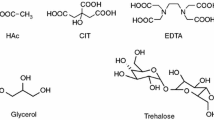Summary
Purified antifreeze proteins (AFPs) from the larvae of the beetle Dendroides canadensis do not produce the high levels of antifreeze activity seen in the hemolymph of overwintering larvae, even when the purified AFPs are assayed at very high concentrations. However, addition of certain proteins or agar (at concentrations sufficiently low that the gel state does not result) to the Dendroides AFP resulted in a 2–3-fold increase in activity. A 70-kDa protein with AFP-activating capabilities was purified from Dendroides larvae. Addition of this endogenous activator protein to a 4 mg·ml-1 solution of AFP increased the activity of the AFPs to values comparable to those of the hemolymph of overwintering larvae. Data derived from a modified immunoblot technique demonstrate that the activators bind to the AFP, or vice versa. Formation of this association must allow the AFP to block ice crystal growth by binding to the surface of potential seed crystals in the normal fashion. However, because the AFP-activator complex is much larger than the AFP alone, the complex probably blocks a greater surface area of the crystal and is thus a more efficient antifreeze.
Similar content being viewed by others
Abbreviations
- AFP :
-
antifreeze protein
- BSA :
-
bovine serum albumine
- DEAE :
-
diethylaminoethyl
- Ig :
-
immunoglubolin
- LPIN :
-
lipoprotein ice nucleator
- PIN :
-
protein ice nucleator
- SDS :
-
sodium dodecyl sulfate
- PAGE :
-
polyacrylamide gel electrophoresis
- TH :
-
thermal hysteresis
References
Davies PI, Hew CL, Fletcher GL (1988) Fish antifreeze proteins: Physiology and evolutionary biology. Can J Zool 66: 2611–2617
Davies PC, Hew CL (1990) Biochemistry of fish antifreeze proteins. FASEB J 4: 2460–2468
DeVries AC (1971) Freezing resistance in fishes. In: Hoar WS, Randall DJ (eds) Fish physiology Vol. 6 pp 157–190. Academic Press, New York
DeVries AC (1983) Antifreeze peptides and glycopeptides in coldwater fishes. Ann Rev Physiol 45: 245–260
DeVries AC (1984) Role of glycopeptides and peptides in inhibition of crystallization of water in polar fishes. Phil Trans R Soc Lond B 304: 575–588
DeVries AC (1986) Antifreeze glycopeptides and peptides: Interactions with ice and water. Methods Enzym 127: 293–303
Duman JG (1980) Factors involved in the overwintering survival of the freeze tolerant beetle, Dendroides canadensis. J Comp Physiol 136: 53–59
Duman JG (1984) Thermal hysteresis antifreeze proteins in the midgut fluid of overwintering larvae of the beetle Dendroides canadensis. J Exp Zool 230: 355–361
Duman JG, Xu L, Neven LG, Tursman D, Wu DW (1991) Hemolymph proteins involved in insect subzero temperature tolerance: Ice nucleators and antifreeze proteins. In: Lee RE, Denlinger DL (eds) Insects at Low Temperature, Chapman and Hall, New York, London pp 94–127
Diffley P, Scott JO, Mama K, Tsen TNR (1987) The rate of proliferation among African trypanosomes is a stable trait that is directly related to virulence. Am J Trop Med Hyg 36: 533–540
Feeney RE, Burdham TS (1986) Antifreeze glycoproteins from polar fish blood. Ann Rev Biophys Chem 15: 59–78
Knight CA, DeVries AL (1989) Melting inhibiton and superheating of ice by an antifreeze glycopeptide. Science 245: 505–507
Neven LG, Duman JG, Low MG, Sehl LC, Castellino FJ (1989) Purification and characterization of an insect hemolymph lipoprotein ice nucleator: evidence for the importance of phosphatidylinositol and apolipoprotein in the ice nucleator activity. J Comp Physiol B 159: 71–82
Raymond JA, DeVries AL (1977) Adsorption inhibition as a mechanism of freezing resistance in polar fishes. Proc Natl Acad Sci USA 74: 2589–2593
Raymond JA, Wilson P, DeVries AL (1989) Inhibition of growth of nonbasal planes in ice by fish antifreezes. Proc Natl Acad Sci USA 86: 881–885
Towbin H, Stachelin T, Gordon J (1979) Electrophoretic transfer of proteins from polyacrylamide gels to nitrocellulose sheets: Procedure and some applications. Proc Natl Acad Sci USA 76: 4350–4354
Towbin H, Gordon J (1984) Immunoblotting and dot immunobinding: Current status and outlook. J Immunol Methods 72: 313–340
Wu DW, Duman JG, Xu L (1991a) Enhancement of insect antifreeze protein activity by antibodies. Biochim Biophys Acta 1076: 416–420
Wu DW, Duman JG, Cheng C-HC, Castellino FJ (1991b) Purification and characterization of antifreeze proteins from larvae of the beetle Dendroides canadensis. J Comp Physiol B 161: 271–278
Xu L, Duman JG (1991) Involvement of juvenile hormone in the induction of antifreeze protein production by fat body in larvae of the beetle Dendroides canadensis. J Exp Zool (in press)
Zachariassen KE, Baust JG, Lee RE (1982) A method for the quantitative determination of ice nucleating agents in insect hemolymph. Cryobiology 19: 180–184
Author information
Authors and Affiliations
Rights and permissions
About this article
Cite this article
Wu, D.W., Duman, J.G. Activation of antifreeze proteins from larvae of the beetle Dendroides canadensis . J Comp Physiol B 161, 279–283 (1991). https://doi.org/10.1007/BF00262309
Accepted:
Issue Date:
DOI: https://doi.org/10.1007/BF00262309



